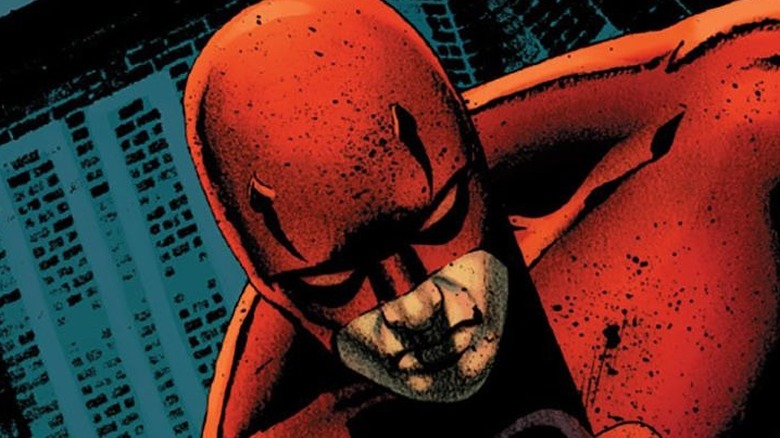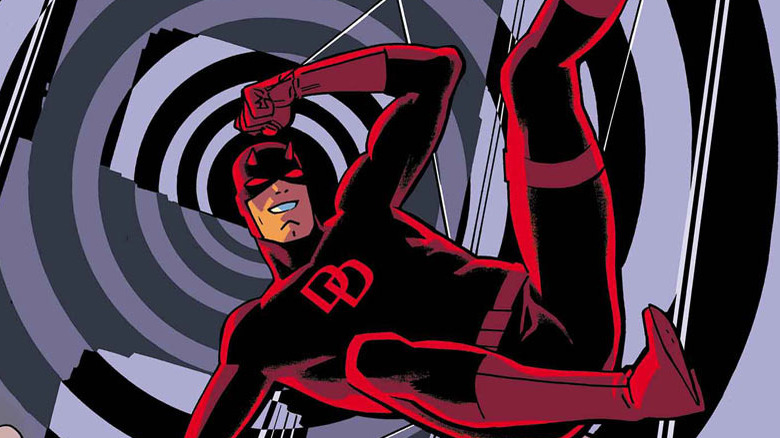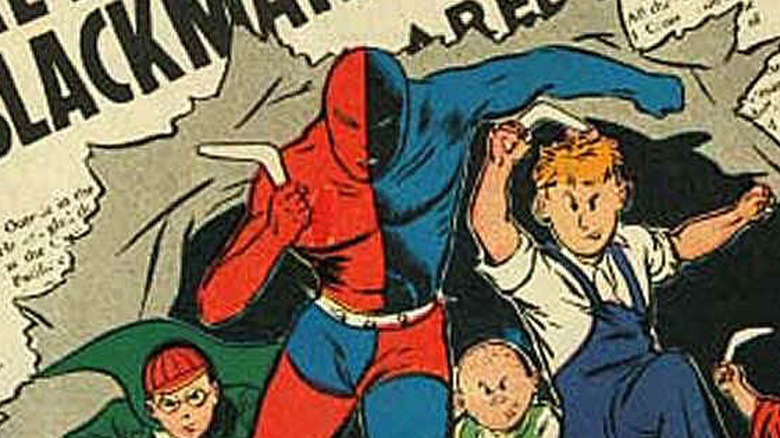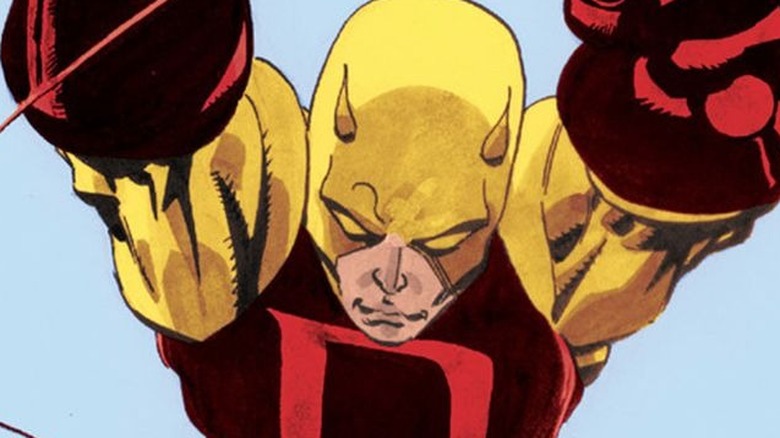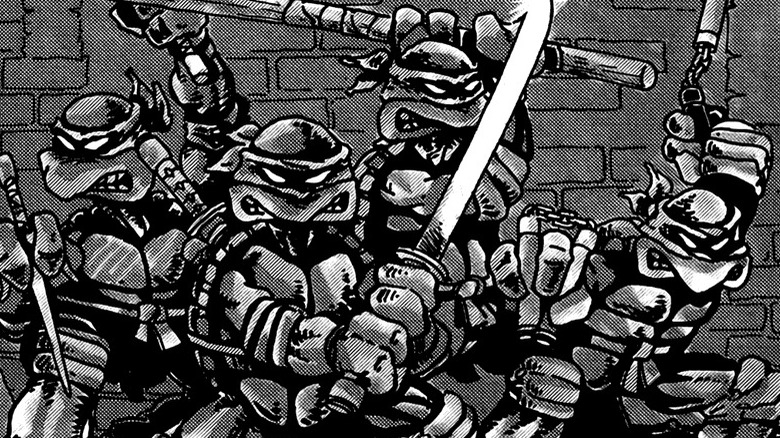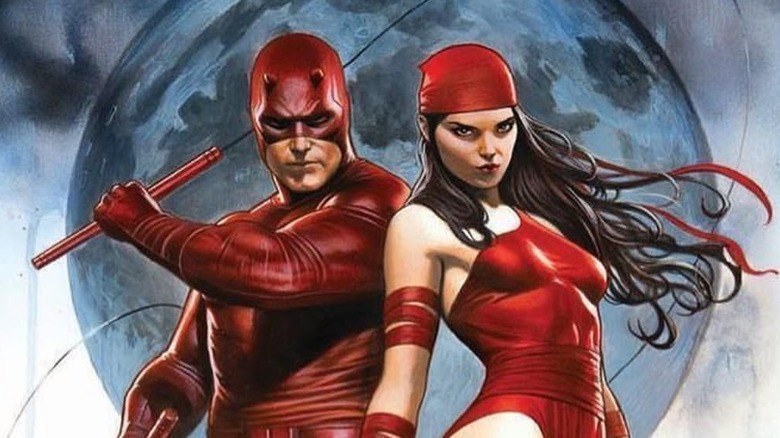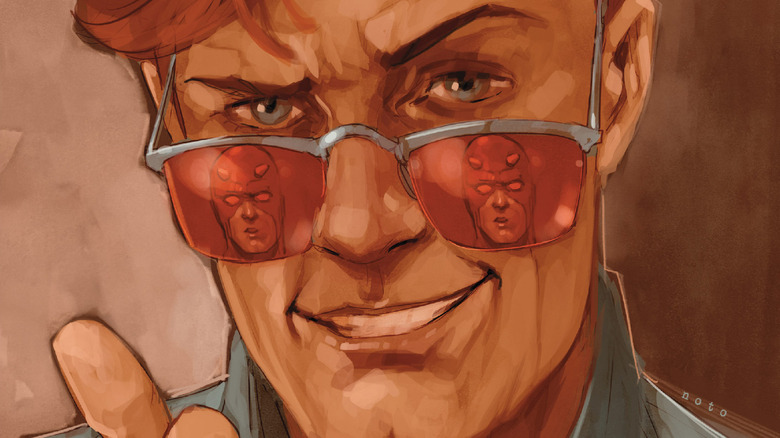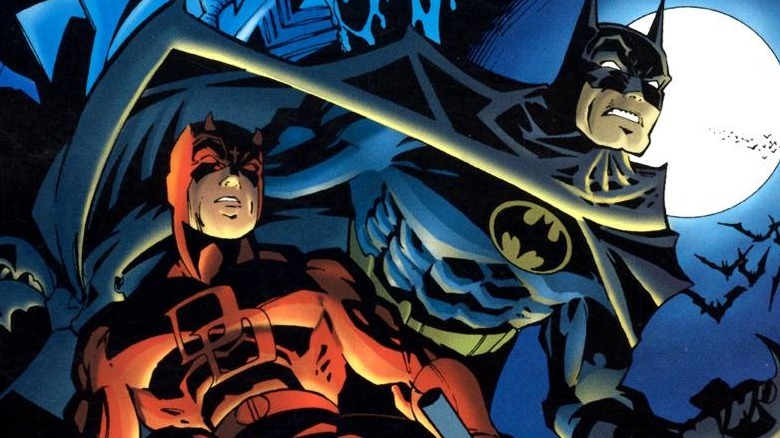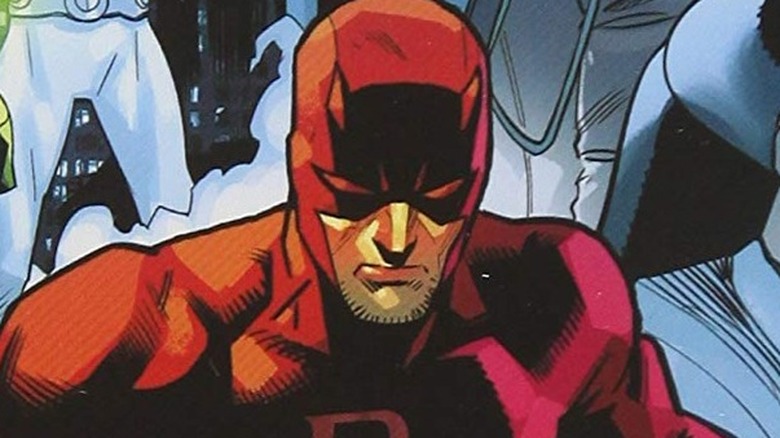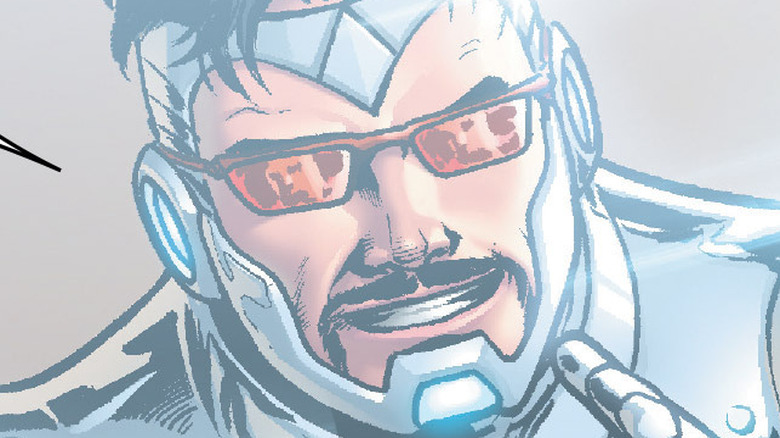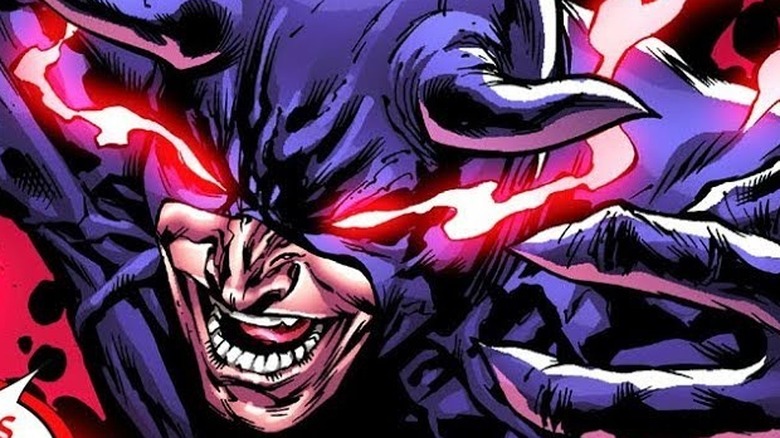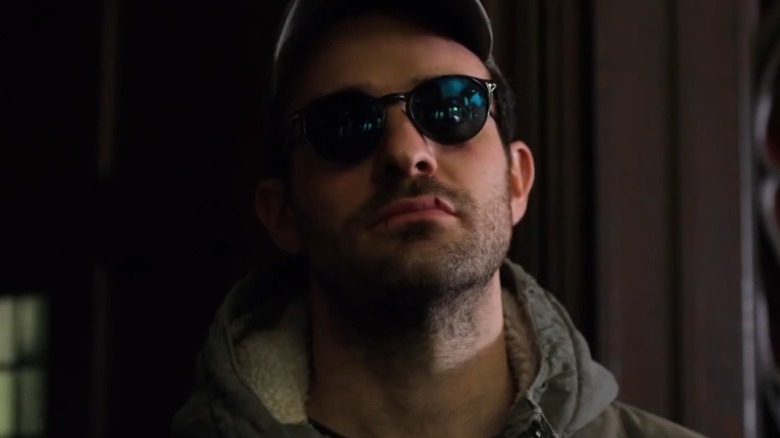The Untold Truth Of Daredevil
Even to those who are unaware of his secret identity, there is more to Matthew Michael "Matt" Murdock than meets the eye. By day, he works as a lawyer, ensuring that everyone gets a fair shot at receiving justice and due process. By night, he works well outside the boundaries of the law as a costumed vigilante, aiming to right the wrongs of those whom the hands of the law have difficulty reaching. Perhaps most impressively, he is able to accomplish these things despite being blind.
Though a selfless act of heroism in his youth permanently robbed Matt of his eyesight, his other senses were dialled up far beyond the limitations of an ordinary human being. As the so-called Devil of Hell's Kitchen, Matt serves as the self-appointed "guardian devil" of his neighborhood, a scarlet protector of the streets who's not above using his fists and his sticks to put fear in the hearts of the city's seediest scum.
As one of the early players in Marvel's Silver Age superhero boom, Matt and his red-clad alter-ego have had a long and fascinating history. From his part in the genesis of one of the world's most successful independent comic books to his long and difficult road towards television stardom, here is the untold truth of Daredevil, the Man Without Fear.
Daredevil: The first blind superhero?
Daredevil was part of a then-new wave of comic book superheroes from Marvel with real-world problems: Spider-Man was a perpetually broke teenager with an ailing aunt and romance troubles, the X-Men were outcasts protecting a world that hated and feared them, and Iron Man was a billionaire weapons manufacturer kept alive solely by a special chest plate. However, the fact that Daredevil can't see makes him truly unique among Marvel's super-powered pantheon.
That said, contrary to what some may assume, Daredevil wasn't co-created by Stan Lee and Bill Everett for the purposes of representation (via ABC News). Lee wasn't motivated by any particularly strong advocacy for the blind; in fact, he was worried that the blind might take issue with his co-creation. "The one thing that worried me about Daredevil—I wondered if blind people would be offended, because we were exaggerating so much what a blind person can do, and they might have felt that we're making it ridiculous," he said. (via the American Foundation for the Blind).
Daredevil may be the first blind superhero to achieve mainstream popularity, but he certainly wasn't the first comic book protagonist to be hampered by some form of blindness. The DC Comics character Dr. Mid-Nite struggles with being unable to see in the presence of light, while having no problem at all seeing in pitch darkness. Dr. Mid-Nite uses this to his advantage, operating under the cover of darkness to fight criminals.
Not the first 'Daredevil' in comics
These days, Matt Murdock is the first (and for many, only) person who comes to mind when someone mentions the superhero codename Daredevil. However, back in 1940, another costumed crimefighter used the same alias in his comic book adventures — and like the modern-day superhero, the original Daredevil was also both athletic and disabled.
1940's "Silver Streak Comics" #6 saw the debut of the Daredevil of the Golden Age, clad in a costume that was half yellow and half blue (via Pop Matters). This Daredevil's secret identity is Bart Hill, who witnessed the murder of his father as a young boy and was also injured with a hot iron. The orphan lost the ability to speak, and grew up motivated by a desire for revenge. He learned how to use boomerangs effectively as weapons, and upon reaching adulthood, embarked on a mission to fight crime in the city.
Interestingly, his appearance in the next issue got rid of nearly all the initially established aspects of his character. He received a costume makeover — with the yellow parts of his suit turned red — and even regained his capability to talk. These changes proved to be beneficial to the character, who enjoyed enough success for the publishing house, Lev Gleason Publications, to spin him off into his own eponymous book about a year later. The character eventually became part of the public domain, and even joined the supporting cast of the Image Comics series "Savage Dragon."
The infamous yellow costume
When Matt Murdock first appeared in 1964's "Daredevil" #1, he was wearing a far more eye-catching color combination than the all-red suit that he is most commonly associated with. While it is hard to say for sure exactly who designed Daredevil's first costume, credit is typically given to Bill Everett and, to a lesser degree, Jack Kirby. (Everett allegedly said that Daredevil's signature billy club weapons were the brainchild of Kirby himself, according to comic book writer and historian Mark Evanier.)
The 2001 miniseries "Daredevil: Yellow" provided a touching explanation as to why Matt initially decided to fight crime in such a bright, attention-grabbing ensemble. Matt actually used his father's boxing gear — including his robe, gloves, and boots — in crafting the costume he wore in his public debut, as a tribute to the loved one who was taken away from him. As the comic book series revealed, it took Matt almost two days to finish sewing his costume by hand, and it served as a powerful reminder of what he had just lost and why he set out to fight crime as both a lawyer and a superhero.
However, Matt would only wear the yellow suit for six issues before another legendary comic book creator, Wally Wood, introduced the now-iconic red costume for the hero in 1965's "Daredevil" #7.
Daredevil and the Teenage Mutant Ninja Turtles
In 1984's "Teenage Mutant Ninja Turtles" #1, the world was introduced to Leonardo, Donatello, Raphael, and Michelangelo (misspelled for a very long time as "Michaelangelo"). Their sudden, unexpected rise to fame turned them into a global, multibillion-dollar pop culture phenomenon almost overnight. That said, these four reptilian martial artists owe their success — and their very existence — to the superhero whose origin story they referenced in their own: Daredevil, who happened to be TMNT co-creator Kevin Eastman's favorite character.
As Eastman shared in an interview with Supanova, "I always thought it was funny that in the Daredevil origin, there was a truck carrying radioactive nuclear waste... [it] hit young Matt Murdock in the eyes, which took away his sight, but helped him enhance his powers and stuff. In Daredevil they never said what happened to the canister, so [in] our story, we kind of decided to have it continue bouncing down the street, and that was sort of our stuff's origin for the Turtles."
Aside from Daredevil's origin, many elements of his world influenced the Turtles. For instance, Daredevil fought the criminal organization called the Hand; meanwhile, the Turtles had their hands full with the evil group called the Foot. The TMNT were trained by a mutated rat-human named Splinter, while Daredevil honed his unique abilities to fight crime with the help of his master, Stick. As Eastman put it: "We ripped [Daredevil] off enough that Marvel probably should have sued us, but didn't."
The many loves of Matt Murdock
Matt Murdock may be blind, but he has never let that get in the way of finding and appreciating beauty, especially in the numerous love interests he has had over the years. From a dangerous affair with the murderous criminal Typhoid Mary to settling down and trying to find some semblance of normalcy with Milla Donovan, to say that Matt has had a colorful relationship history would be an understatement.
At one point, Daredevil found himself romantically involved with Echo, the adoptive daughter of his archnemesis, Wilson Fisk a.k.a. the Kingpin. Fisk had manipulated Echo into believing that Daredevil was responsible for the death of her father, but she eventually discovered the truth and turned on him. Another hero whom Daredevil fell in love with was Black Widow. For a time, they even co-headlined a comic book series.
Out of all of Daredevil's relationships, however, the two most meaningful ones were the ones laced with the greatest degree of tragedy. Karen Page was Matt's first major romantic interest in the comics, forming a love triangle with his best friend and law firm partner, Franklin "Foggy" Nelson. Elektra, on the other hand, is perhaps Daredevil's greatest love; she even took over as Daredevil when Matt was imprisoned. Sadly, both Karen and Elektra met violent deaths at the hands of one of Daredevil's most dangerous foes, the hyper-accurate assassin known as Bullseye (though Elektra eventually managed to return to life).
Matt Murdock's twin brother, Mike Murdock
It's a common comic book trope: In a desperate bid to protect their secret identity, the superhero comes up with a ridiculous plan involving someone else as a scapegoat, in order to draw suspicious people off the scent. In Matt Murdock's case, the brilliant lawyer thought that the best way to maintain his facade was to pretend to be his own loud, extroverted twin brother — a lie that surprisingly worked, but came back to bite him many years later.
In 1967's "Daredevil" #25, Matt pretends to be "Mike Murdock," his audacious, obnoxiously dressed, devil-may-care twin brother who also happens to have the questionable habit of loudly revealing his secret identity as the Man Without Fear. Despite the inherent silliness of this ruse, Matt convinces the people around him that his loudmouth "twin" is in fact Daredevil (and not him). However, after some time, Matt decided that it was time to put the Mike Murdock identity to rest indefinitely. Matt concocts another scheme to "kill" Mike, claiming that a different person replaced him as Daredevil.
Fast forward to 2018's "Daredevil" #606, when a collaboration with an Inhuman called Reader accidentally leads to the creation of a real, flesh-and-blood Mike Murdock based on Matt's memories. Mike, who believes himself to be a true human being, escapes from Matt before the mistake could be corrected. Matt successfully finds him, but decides to let him lead a life of his own.
Daredevil and Batman
One can argue that Marvel's Daredevil and DC's Batman make for interesting cross-universe counterparts. After all, they do share quite a few things in common (including the fact that Ben Affleck portrayed both of them on the silver screen). Thus, it isn't really surprising that back when the two comic book companies were actively doing crossover books featuring their respective characters, the two urban knights ended up co-starring in their own special one-shots — not once, but twice.
1997's "Daredevil/Batman: Eye for an Eye" marks the first meeting between the Dark Knight of Gotham City and the Devil of Hell's Kitchen. In this alternate reality story, Batman villain Two-Face teams up with Marvel baddie Mr. Hyde in the theft of a powerful computer microchip. Daredevil and Batman are forced to work together to put a stop to the terrible twosome's plans. An interesting (but ultimately non-canon) detail revealed in the story: Years before their respective transformations, Matt Murdock and Harvey Dent actually knew each other as law students.
A sequel, "Batman/Daredevil: King of New York," was published in 2000, and featured the Caped Crusader and the Man Without Fear teaming up once more. This time, they find themselves at odds against two of their most dangerous villains: the immortal eco-terrorist Ra's al Ghul and the criminal megaboss the Kingpin.
When Daredevil became the Kingpin
Among all of Daredevil's enemies, few have managed to strike as close to Matt Murdock's heart as the Kingpin. Originally a Spider-Man villain, Wilson Fisk gradually became the biggest thorn in Daredevil's side over the years. The two powerful men have since developed a raging, boiling hatred for each other, which is almost always on the verge of spilling over. And 2003's "Daredevil" #50 showed exactly what would happen when the otherwise self-restrained Daredevil decides to unleash the full extent of his abilities upon his mortal foe.
Sick and tired of the maelstrom unleashed upon his private life following the public revelation of his secret identity, Daredevil tracks down the Kingpin and finds him in an abandoned warehouse. A brutal, bloody, no-holds-barred brawl follows, with both combatants putting in all they've got in order to finally end their conflict. A raging Matt emerges triumphant after beating Fisk to within an inch of his life, and comes to the decision that the only way to soundly defeat him is to take over. He brings the beaten body of Fisk to Josie's Bar, a hotbed of organized crime in New York, and makes a bold declaration: He is now the new Kingpin, and anyone who dares to commit any crimes in his neighborhood will suffer terrible consequences. While things eventually returned to status quo, this brief period in Matt's life showed a side of him rarely seen by anyone else.
He has regained his eyesight multiple times
While Daredevil's blindness is his most well-known trait, there have been numerous occasions in which he regained the use of his eyes. However, pretty much all of them proved that Daredevil is really better off without his eyesight.
One of the earliest instances of this was in 1967's "Daredevil" #38. In one of his evil schemes, Dr. Doom uses a machine to switch bodies with Daredevil. As Matt occupies Doom's body, he temporarily gains the ability to see again. On another occasion, in "Daredevil" vol. 1 #106, the cosmic adventurer Moondragon grants Daredevil the temporary ability to see, so that the hero could save her. Another otherworldly being, the Beyonder, becomes the catalyst for Matt being able to see again in "Daredevil" vol. 1 #223. In his bid to acquire Earth, the Beyonder seeks legal representation from Matt and Foggy, with Matt's eyesight being part of the retainer. Ultimately, Matt gives it up and refuses to represent him. In 1998's "Daredevil" #376, a secret S.H.I.E.L.D. mission goes awry, leaving an amnesiac (but no longer blind) Matt Murdock stuck in a different country with no clue as to who he's really supposed to be.
"Superior Iron Man" #2, published in 2015, tests Matt's resolve yet again. A villainous Tony Stark offers him the ability to see, at the cost of Matt's compliance with his sinister agenda. When Daredevil refuses, Tony not only takes away the gift, but also wipes Matt's memory of what happened.
The demonic possession of Daredevil
As both a lawyer and a superhero, Matt Murdock is a firm believer of working both inside and outside the system in order to fix it. That's exactly what he attempted to do when he took over the Hand in a well-meaning (albeit ultimately misguided) attempt to "fix" it. Unfortunately, it ended with him being possessed by an actual demonic entity — and by the time it was over, the criminal organization had joined hands (pun not intended) with Daredevil's greatest enemy.
In the 2010 limited series Shadowland, Daredevil decides to put an end to his years-long conflict with Bullseye by driving a sai through the villain — an act of violence that, under normal circumstances, Daredevil would never undertake. As Matt becomes increasingly corrupted by the influence of the Beast of the Hand, the street-level heroes of New York City band together to stop him and attempt to save their friend's soul before it's too late. A climactic battle takes place at the Hand's newly constructed Shadowland stronghold, in which Daredevil seemingly sacrifices himself to defeat the demon that possessed him. The story ends with Matt going on self-imposed exile, while none other than the Kingpin steps in to claim leadership of the Hand in Matt's place.
It took at least six tries for him to get a TV show
The Netflix "Daredevil" series is widely regarded as the best production among the entire Netflix Marvel crop, with Charlie Cox's Daredevil and Vincent D'Onofrio's Kingpin even making their way to the larger Marvel Cinematic Universe. However, the road to the Man Without Fear getting his own TV show was certainly not without hardships.
According to ManWithoutFear.com, there were plans for a live-action TV show in 1983 that starred Benny Carruthers as Daredevil and Angela Bowie as Black Widow. However, due to special effects difficulties and budget constraints, the project was scrapped. Six years later, the made-for-TV movie "Trial of the Incredible Hulk" featured the live-action debut of Daredevil, portrayed by Rex Smith. This would have led to the character getting his own solo series with Smith in the titular role, but the pilot was not picked up by any network.
Daredevil didn't have much luck on the animated front, either. A failed animated series pitch dated 1979 featured Matt Murdock and Foggy Nelson as co-owners of a law firm, with Karen Page as a private investigator working for them. Comic Book Resources also reported that in 1985, Marvel briefly entertained the idea of giving Daredevil his own cartoon (with a seeing-eye dog, to boot). Lastly, a "Spider-Man: The Animated Series" spin-off series featuring Daredevil was pitched in 1999, but was delayed and ultimately never materialized.
Daredevil vs. Spider-Man: Who's had it worse?
Spider-Man and Daredevil have one of the most well-known and enduring friendships in comics, and with good reason. Both are street-level heroes based in New York City who are more commonly seen fighting on behalf of the little guy than dealing with universe-ending cosmic threats. They're also two peas in a pod when it comes to their assorted misfortunes in life.
Peter Parker's personal tragedies are nothing to scoff at, of course. His origin story involves his uncle's death at the hands of a criminal he could have stopped. He has seen so many loved ones die as a consequence of his superheroic life, including his girlfriend Gwen Stacy. He has been hunted by an interdimensional vampire, involuntarily mind-swapped with his greatest foe, and had his marriage undone by the devil.
However, one can argue that between the two, perhaps the Man Without Fear has had it just a little bit worse. In addition to being blinded by chemicals and learning about his father's murder as a young boy, he has also been publicly outed as Daredevil multiple times, imprisoned repeatedly, and even disbarred. He has barely escaped death numerous times, experienced losing his memory in a foreign land, and even witnessed the death of a romantic partner not once, but twice.
